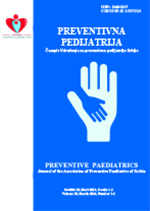CHALLENGES, LESSONS LEARNED AND INTERNATIONAL COLLABORATION IN PROVIDING PREVENTIVE TREATMENT OF MULTIDRUG-RESISTANT TUBERCULOSIS (DR TPT) IN CHILDREN IN SERBIA
DOI:
https://doi.org/10.46793/PP250225006SKeywords:
preventive therapy, multidrug-resistant tuberculosis, adolescents, childrenAbstract
Drug-resistant forms of TB continue to be the global public health threats. Multidrug-resistant TB (MDR-TB) is defined as TB resistant to rifampicin and isoniazid, essential anti-TB drugs. Both MDR-TB and rifampicin-resistant TB (RR-TB) are treated with second line anti-TB drugs. Preventing the progression of a drug-resistant tuberculosis (DR-TB) infection to disease is an important pillar of the DR-TB elimination strategy. International guidelines have recently proposed fluoroquinolones for tuberculosis preventive therapy (TPT) in DR-TB contacts. Till 2019, no preventive therapy for MDR TB contacts has been performed in Serbia since it was not included in the national TB treatment and contact tracing guidelines. In 2019 and 2022 for the first time, several children and adolescents appeared as close contact with MDR TB cases. DR TB preventive treatment was performed at Hospital for Children's Lung Diseases and TB, “Dr Dragisa Misovic” Clinic in Belgrade, Serbia in two children aged 2 and 3, in line with latest WHO guidelines, due to international collaboration and national multidisciplinary expert support. During the implementation of TPT for child contacts of MDR TB, we have learned that our capacities for TB program coordination, international and in-country multidisciplinary expert collaboration, epidemiological investigation, contact tracing as well as DS and DR TB management in children are good. However, we faced a lot of legislation and systemic challenges that affected the implementation of DR TPT. The main challenges were lack of pediatric drug formulations, lack of indications for levofloxacin use for TB and use in this age group.
References
Global tuberculosis report 2024. Geneva: World Health Organization; 2024.
Global tuberculosis report 2021. Geneva: World Health Organization; 2021.
Stosic Maja. Risk factors for multidrug-resistant TB among TB patients: a case-control study. Doctoral Dissertation. School of Medicine, Belgrade University, Serbia, Belgrade, 2019.
STOP TB Partnership. Global Drug Facility. Available at: https://www.stoptb.org/what-we-do/facilitate-access-tb-drugs-diagnostics/global-drug-facility-gdf
Savić B, Vuković D, Dakić I, Aranđelović I. Guidelines for Microbiological Diagnosis of Tuberculosis (3rd edition). Belgrade: Ministry of Health of the Republic of Serbia; 2015.
Institute of Public Health of Serbia “Dr Milan Jovanovic Batut” Report on communicable diseases in Serbia for 2023. Belgrade, 2024.
WHO consolidated guidelines on tuberculosis. Module 4: treatment - drug-resistant tuberculosis treatment, 2022 update. Geneva: World Health Organization; 2022.
WHO consolidated guidelines on drug-resistant tuberculosis treatment. Geneva: World Health Organization; 2019.
Kherabi Y, Tunesi S, Kay A, Guglielmetti L. Preventive Therapy for Contacts of Drug-Resistant Tuberculosis. Pathogens. 2022;11(10):1189. doi: 10.3390/pathogens11101189. PMID: 36297246.
Sepkowitz KA. How contagious is tuberculosis? Clin Infect Dis. 1996;23(5):954-962. doi: 10.1093/clinids/23.5.954. PMID: 8922785.
Andrews RH, Devadatta S, Fox W, Radhakrishna S, Ramakrishnan CV, Velu S. Prevalence of tuberculosis among close family contacts of tuberculous patients in South India, and influence of segregation of the patient on early attack rate. Bull World Health Organ. 1960;23(4-5):463-510. PMID: 13683486.
Shah NS, Yuen CM, Heo M, Tolman AW, Becerra MC. Yield of contact investigations in households of patients with drug-resistant tuberculosis: systematic review and meta-analysis. Clin Infect Dis. 2014;58(3):381-391. doi: 10.1093/cid/cit643. PMID: 24065336.
Kim S, Wu X, Hughes MD, Upton C, Narunsky K, Mendoza-Ticona A, et al; ACTG A5300/IMPAACT 2003/PHOENix Feasibility Study Team. High Prevalence of Tuberculosis Infection and Disease in Child Household Contacts of Adults With Rifampin-resistant Tuberculosis. Pediatr Infect Dis J. 2022;41(5):e194-e202. doi: 10.1097/INF.0000000000003505. PMID: 35239624.
WHO consolidated guidelines on tuberculosis. Module 1: prevention – tuberculosis preventive treatment, second edition. Geneva: World Health Organization; 2024.
Radosavljevic Asic G, Rebic P, Kuruc V. Methodological guidelines for tuberculosis prevention and control. Belgrade: Ministry of Health of the Republic of Serbia; 2009.
Curcic R, Sagic L, Kuruc V. Guidelines for contact tracing, latent tuberculosis infection and chemoprophylaxis. Belgrade: Ministry of Health of the Republic of Serbia; 2011.
D'Ambrosio L, Tadolini M, Centis R, Migliori GB. A new free-cost e-service supporting clinicians to manage their difficult-to-treat TB cases: the ERS-WHO TB Consilium. J Thorac Dis. 2015;7(7):1080-1085. doi: 10.3978/j.issn.2072-1439.2015.07.15
Živković Z, Ostojić O, Veković V, Stojković A, Stojanović O, Matić M, et al. Pulmonary Tuberculosis and Spontaneous Pneumothorax in an Adolescent – Case report. Prev Ped, 2023; 9 (1-2): 89–92.
Stolbrink M, Ozoh OB, Halpin DMG, Nightingale R, Meghji J, Plum C, et al; Chronic Respiratory Diseases Medicines Survey Investigators Collaboration. Availability, cost and affordability of essential medicines for chronic respiratory diseases in low-income and middle-income countries: a cross-sectional study. Thorax. 2024;79(7):676-679. doi: 10.1136/thorax-2023-221349. PMID: 38760170.
Živković Z, Paton J. Pulmonary TB, latent TB and in vivo and in vitro tests. In: Eber E, Midulla F. (Editors). Pediatric Respiratory Medicine. European Respiratory Society. 2nd ed. European Respiratory Society; 2013. p. 270-284.





